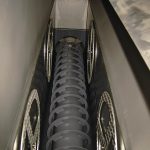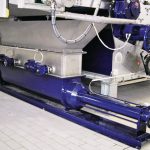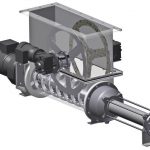Highly dewatered sewage sludge is characterised not only by poor flow properties but also by an increased tendency to form material bridges. Unfortunately, these bridges impede the continuity of the material flow. The aBP (asynchronous Bridge Preventing) module provides an efficient answer here. This intelligent feed system for progressing cavity pumps is designed with side wheels in the feeder chute to prevent lumps from forming.
The author: Thomas Böhme Head of Environment and Energy Business Unit, Netzsch Mohnopumpen
What is the best way to convey dewatered sewage sludge to the nearest landfill or incineration plant? This is a question that frequently also confronts operators of industrial wastewater treatment plants. The dilemma: as much water as possible needs to be removed from the sludge in order to reduce the costs of conveyance. This simultaneously facilitates the incineration process, of course. On the other hand, the dewatered, flocculated sludge tends to form bridges in the feed hopper, so that it is no longer able to drop through. Time-consuming, cost-intensive faults in the conveyance system are the outcome.
Aiming to put a stop to this problem, Netzsch Mohnopumpen has come up with a system with an integrated bridge breaker. The Nemo BF progressing cavity pump is specially designed for highly viscous media, while the add-on aBP module prevents the formation of lumps by means of four side wheels in the feeder chute. Downtimes due to bridging in the conveyance system are now a thing of the past.
The problem described above was only too familiar to the owner of the wastewater treatment plant in Celle, a small town in northern Germany. „It makes no difference that this is a municipal facility – the challenge is exactly the same as with an industrial one“, asserts Helmut Hentrich of Netzsch Mohnopumpen. The sewage sludge in Celle is conveyed to a silo over a distance of about 25 m – including 10 m vertical – via a pressure pipe with several 90 ° bends. To enable the mixture to be stored, it is dewatered in a sludge press prior to adding flocculant. The viscosity of the resulting medium varies between 10 and 22 Pa s, and the dry matter content between 25 and 35 %, depending on the conditioning process, composition and temperature.
The bulk of sewage sludge is then poured into the conveyance system via a hopper. However, entanglement and bridging were regularly observed here owing to the high cohesiveness. The medium got stuck at the top of the chute and the pump unit ran dry and kept failing. “The operational downtime amounted to three or fours hours a week in all”, Hentrich recalls.
No material clogging
The Waldkraiburg pump specialists developed the aBP (asynchronous Bridge Preventing) module for precisely this kind of scenario. It comprises a top chute with spoked wheels attached to the inside. The wheels are mounted deep inside the chute very close to the walls. When they turn, the effect on the medium being poured in is as if the entire chute sides were moving. The shear effect this produces tears the bridges apart in the early stages of formation, so that the mixture can be conveyed continuously. The structured surface of the stainless steel wheels further supports this effect and assists agitation in the hopper. As the middle of the chute now remains free, the fill level can be assessed at any time and readjusted if necessary.
The wheels are driven by independent worm gears with a variable differential speed that can thus be tailored to each medium conveyed. The aBP module typically comprises two spoked wheels. However, since larger quantities have to be transferred in the wastewater treatment plant, a two-metre long feed hopper with four wheels (two on each side) was preferred in this particular case. The required driving power per wheel is only 0.18 kW and the speed less than 30 min-1. Two frequency converters are provided for control.
Precisely controllable dose rate
The sewage sludge drops directly out of the hopper chute into the force-feed chamber of a Nemo BF progressing cavity pump. “This model was chosen because it is a good workhorse and has a very compact design”, says Hentrich. The equipment was specially developed for highly viscous to compacted media and ensures pressure-stable, low-pulsation conveyance. As the dewatered, flocculated sludge is no longer free-flowing, it is moved evenly into the actual pump chamber via the BF’s patented, horizon-tally positioned screw conveyor. Here, between the progressing cavity pump’s rotor and stator, equal cavities are formed to receive the medium and convey it onward as the rotor turns. The dose rate can be precisely controlled according to the speed in order to achieve a continuous flow of material. The hopper-shaped inlet, which is based on the design of the stator, supports the cavity filling step. Depending on the size, pumping capacities of up to 200 m³/h and differential pressures of 45 bar can be achieved with the Nemo BF. The Celle facility was designed to convey at a rate of 2 to 5 m³/h and a pressure of 12 to 15 bar. The system currently operates at 9 to 11 bar with a dry matter content of 28 to 30 % in the sludge. Even when the plant is started up again after the weekend, the pressure only rises a maximum of 1 or 2 bar and never for more than a few minutes. This stable performance is a decisive factor owing to the long, circuitous conveyance path of the medium on its way to the silo. “The high viscosity of the sewage sludge means there is considerable resistance in the pipe. This must be calculated and, where possible, reduced”, explains Hentrich. To this end, a ring nozzle was installed in the wastewater treatment plant some time ago directly downstream of the pump’s discharge port; it injects poly-lubricant into the pipe, thereby reducing the resistance.
In the meantime, the pumping system with integrated bridge breaker has also proved itself in continuous operation. In spite of the fact that the sewage sludge dry matter content often fluctuates, there is no longer any clogging in the feed hopper. The system is much more reliable and the previously unavoidable conveyor inspections have been virtually eliminated.
cpp-net.com/0112451
Share:











